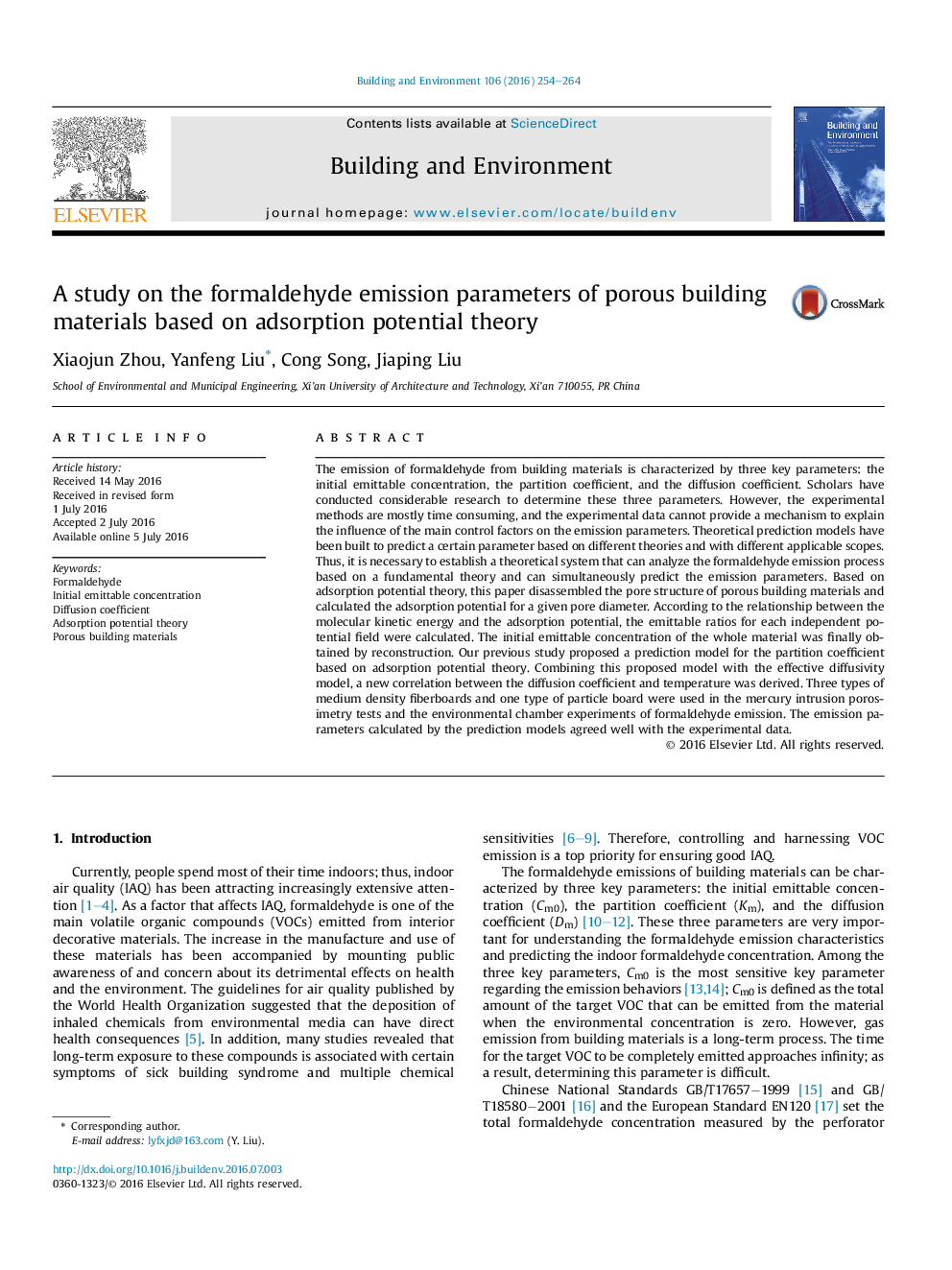| کد مقاله | کد نشریه | سال انتشار | مقاله انگلیسی | نسخه تمام متن |
|---|---|---|---|---|
| 6698820 | 502517 | 2016 | 11 صفحه PDF | دانلود رایگان |
عنوان انگلیسی مقاله ISI
A study on the formaldehyde emission parameters of porous building materials based on adsorption potential theory
ترجمه فارسی عنوان
مطالعه بر روی پارامترهای انتشار فرمالدئید مصالح ساختمانی متخلخل بر اساس نظریه پتانسیل جذب
دانلود مقاله + سفارش ترجمه
دانلود مقاله ISI انگلیسی
رایگان برای ایرانیان
کلمات کلیدی
فرمالدئید، غلظت اولیه انتشار پذیر، ضریب انتشار، تئوری پتانسیل جذب، مصالح ساختمانی متخلخل،
ترجمه چکیده
انتشار فرمالدئید از مصالح ساختمانی با سه پارامتر کلیدی مشخص می شود: غلظت اکتیو شده اولیه، ضریب پراکندگی و ضریب انتشار. محققان تحقیقات زیادی را برای تعیین این سه پارامتر انجام داده اند. با این حال، روش های تجربی بیشتر وقت گیر هستند و داده های تجربی قادر به ارائه مکانی برای توضیح تأثیر عوامل اصلی کنترل بر پارامترهای انتشار نیستند. مدل پیش بینی نظری برای پیش بینی پارامتر خاص بر اساس نظریه های مختلف و با حوزه های مختلف کاربردی ساخته شده است. بنابراین لازم است سیستم نظری ایجاد شود که بتواند فرآیند انتشار فرمالدئید را براساس نظریه اساسی تجزیه و تحلیل کند و به طور همزمان پارامترهای انتشار را پیش بینی کند. بر اساس نظریه پتانسیل جذب، این مقاله ساختار منفی مصالح ساختمانی متخلخل را تخریب کرده و پتانسیل جذب برای یک قطر منافذ داده شده را محاسبه کرده است. با توجه به رابطه بین انرژی جنبشی مولکولی و پتانسیل جذب، نسبت اظهارنامه برای هر میدان بالقوه مستقل محاسبه شد. غلظت اکتیو شده اولیه از کل ماده در نهایت توسط بازسازی به دست آمد. مطالعه قبلی ما یک مدل پیش بینی برای ضریب پارتیشن بر اساس نظریه پتانسیل جذب پیشنهاد کرد. ترکیب این مدل پیشنهادی با مدل موثر انتشار، یک همبستگی جدید بین ضریب انتشار و دما یافت شد. سه نوع فیبرهای ورقه ای با ضخامت متوسط و یک نوع تخته خرده چوب در آزمایش های نفوذ سنجی نفوذ جیوه و آزمایش های محفظه محیطی از انتشار فرمالدئید استفاده شد. پارامترهای انتشار که با استفاده از مدل های پیش بینی محاسبه شده اند با اطلاعات تجربی همخوانی داشتند.
موضوعات مرتبط
مهندسی و علوم پایه
مهندسی انرژی
انرژی های تجدید پذیر، توسعه پایدار و محیط زیست
چکیده انگلیسی
The emission of formaldehyde from building materials is characterized by three key parameters: the initial emittable concentration, the partition coefficient, and the diffusion coefficient. Scholars have conducted considerable research to determine these three parameters. However, the experimental methods are mostly time consuming, and the experimental data cannot provide a mechanism to explain the influence of the main control factors on the emission parameters. Theoretical prediction models have been built to predict a certain parameter based on different theories and with different applicable scopes. Thus, it is necessary to establish a theoretical system that can analyze the formaldehyde emission process based on a fundamental theory and can simultaneously predict the emission parameters. Based on adsorption potential theory, this paper disassembled the pore structure of porous building materials and calculated the adsorption potential for a given pore diameter. According to the relationship between the molecular kinetic energy and the adsorption potential, the emittable ratios for each independent potential field were calculated. The initial emittable concentration of the whole material was finally obtained by reconstruction. Our previous study proposed a prediction model for the partition coefficient based on adsorption potential theory. Combining this proposed model with the effective diffusivity model, a new correlation between the diffusion coefficient and temperature was derived. Three types of medium density fiberboards and one type of particle board were used in the mercury intrusion porosimetry tests and the environmental chamber experiments of formaldehyde emission. The emission parameters calculated by the prediction models agreed well with the experimental data.
ناشر
Database: Elsevier - ScienceDirect (ساینس دایرکت)
Journal: Building and Environment - Volume 106, September 2016, Pages 254-264
Journal: Building and Environment - Volume 106, September 2016, Pages 254-264
نویسندگان
Xiaojun Zhou, Yanfeng Liu, Cong Song, Jiaping Liu,
